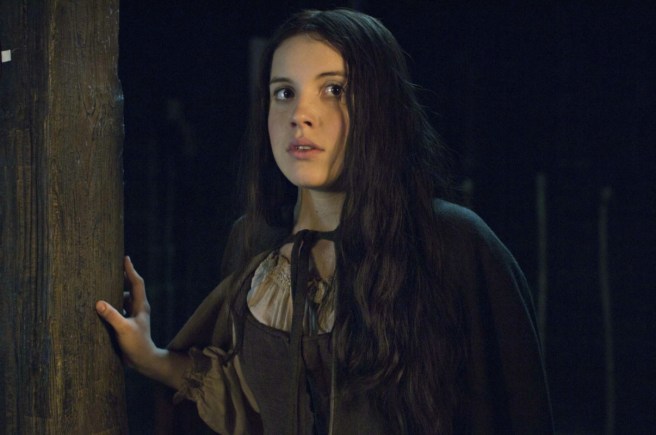I’m very pleased that I finished reading Krabat by Otfried Preußler this summer. Taking it slowly, one part per month, helped me get through and feel that I’d made a real step in German fluency.
Here follows my summary of the third part in German and English, and some final thoughts in English.

Nach Michals Tod passiert alles gleich wie in dem letzten Jahr. Der Meister bleibt verschwindert. Die Mühle steht still, die Zeit scheinbar auch. Am Vorabend des Dreikönigstages kommt der Meister und ruft, “Geht an die Arbeit!” Um Mitternacht ist die Arbeit fertig, und im Schlafzimmer finden die Burschen einen neuen Knirps, Lobosch.
Krabat kennt diesen Knirps schon, von seinem Leben bevor er in der Mühle kam, aber Lobosch kann das nicht glauben; Krabat ist so alt gewachsen. Trotzdem hilft Krabat den Lobosch mit der Arbeit, wie Tonda hat ihm geholfen. Aber er fragt sich auch, wie könnte er von diesem Leben herauskommen? Weil es klar ist, jedes Jahr muss jemand sterben, und warum nicht er selbst?
Ein unerwartete Hilfer findet er in dem “dumme” Juro. Juro weisst mehr als er offenbart, und er erzählt zu Krabat wie er sich frei machen kann. Dafür braucht her Hilfe von einem Mädchen, das von dem Meister beten muss, Krabat zu erlösen. Und es muss ihm wählen von alle die Burschen, die bezaubert werden gleich zu aussiehen. Krabat fängt an, sein Wille zu stärken gegen den Meisters. Er hat Hoffnung, weil Pumphutt den Meister schon besiegen hat.
Aber das ist sehr gefährlich, auch für das Mädchen. Der Meister ist verdächtig. Krabat muss mit der Kantorka sich treffen zu erzählen was wird passieren. Er findet eine Möglichkeit während der Kermess, aber er muss aufpassen; der Meister beobachtet ihn immer.
Das Ende ist sehr spannend. Der Meister will Krabat in der Versuchung zu führen, verspricht ihn Macht, wenn er ihn folgt. Er kann wählen, der neuen Meister zu werden; sonst wird er alle seine Zauberkraft losen.
Es ist keine schwerige Entscheidung für Krabat. Er will in der Welt leben, nicht mehr in diese Todesmühle. Und endlich, mit Hilfe von Juro und die Kantorka, ist er erlöst.

After Michal’s death, everything happens the same as last year. The master remains missing. The mill stands still, time seems to stand still too. On the eve of Epiphany, the master comes and shouts, “Get to work!” At midnight, the work is finished, and in the bedroom the boys find a new kid, Lobosch.
Krabat already knows this boy, from his life before he came to the mill, but Lobosch can’t believe it; Krabat has grown so old. Nevertheless, Krabat helps Lobosch with the work, as Tonda has helped him. But he also wonders, how could he get out of this life? Because it is clear, every year someone must die, and why not he himself?
He finds an unexpected helper in the “stupid” Juro. Juro knows more than he reveals, and he tells Krabat how he can free himself. For this he needs help from a girl who must pray to the master to release Krabat. And she must choose him from all the boys who are enchanted to look alike. Krabat begins to strengthen his will against the master. He has hope, because Pumphutt has already defeated the master.
But this is very dangerous, also for the girl. The Master is suspicious. Krabat must meet with the Kantorka to explain what will happen. He finds a way during the fair, but he must be careful; the master is always watching him.
The end is very exciting. The master wants to lead Krabat in temptation, promising him power if he follows him. He can choose to become the new master; otherwise he will lose all his magic power.
It is not a difficult decision for Krabat. He wants to live in the world, no longer in this death mill. And finally, with the help of Juro and the Kantorka, he is saved.

What’s most interesting in this part that the seemingly stupidest boy is actually the smartest, and also that in the end, Krabat is not saved by the strengthening of his will, but by his compassion for the Kantorka — which she senses, even though the master has blindfolded her.
We also learn why the Master has been bothering with this backwater mill and his students in the first place: it’s the Devil’s testing ground. If a disciple serves long enough he can be promoted to a higher position of evil in the world, creating more war and chaos. Provided, that is, that he finds a pupil to take on his role in the mill. Krabat is wise not to be even tempted by this bargain, which would enmesh him even further in the wheels of darkness.
Krabat is a wonderful story, with its timeless message of choosing love over power, embedded in a historical setting that is conveyed with succinct but convincing detail. Though you may not have read this far if you haven’t read the book — I have not tried to avoid spoilers! — I do recommend reading it in full, whether in the original or in translation.
Images from the German film – see more here.


You inspire me to try to read more in other languages, Lory! Not only did you read in another language, but you also write your review in another language…well done.
I hope you will read more in other languages and let us know how it goes!
The writing is an exercise I set myself as practice. I do think it helps, although it may not be the most fascinating reading.
Ich habe letztes Jahr Krabat gelesen und das Buch geliebt! Die Freundschaft zwischen den Jungen fand ich einfach sehr gut dargestellt. Danke, dass du mich daran erinnert hast 🙂
Ja, das Thema der Freundschaft war toll. Ich bin immer froh, eine “Krabatsfan” zu treffen.